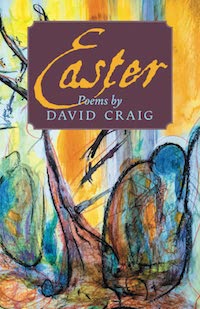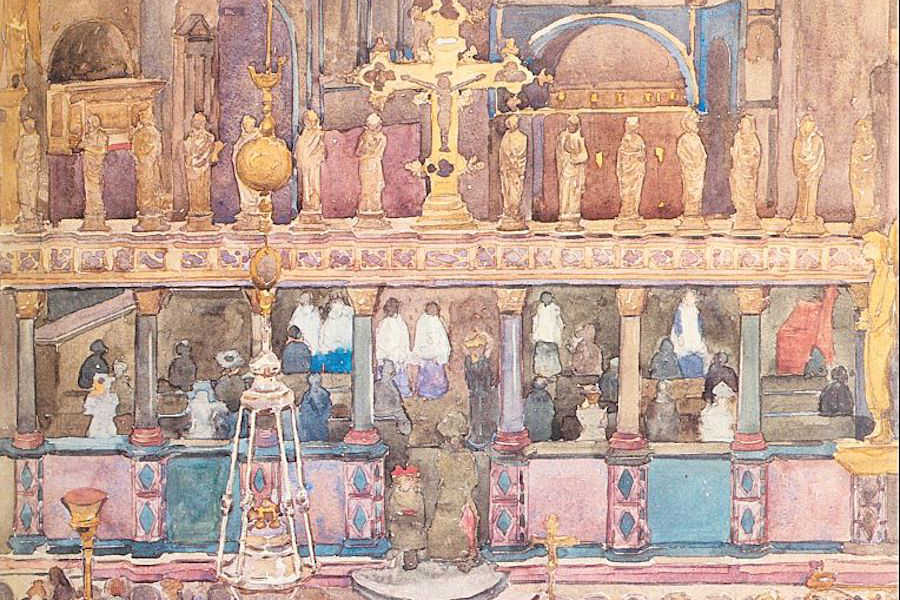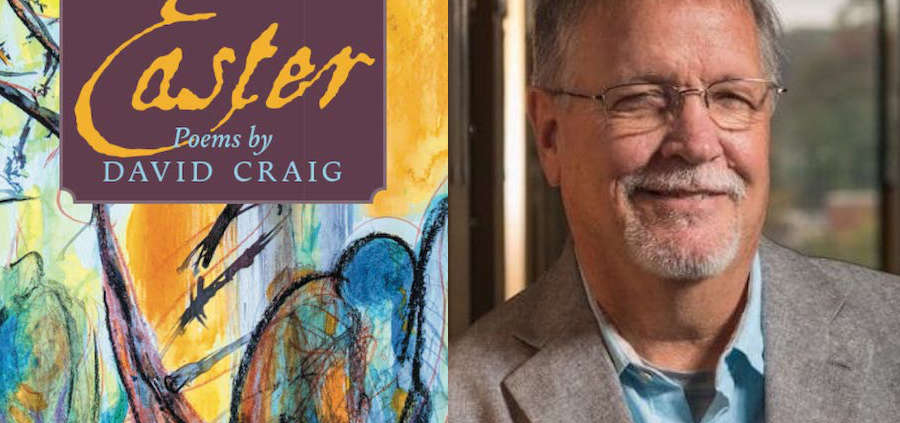Summer Reading Series: Kathryn Sadakierski on David Craig

Easter
By David Craig
Angelico Press, 2022
$12.95 (paperback) / $22 (hardcover)
216 pp.
The ordinary and extraordinary, brokenness and wholeness, old and new. David Craig’s new collection of poems, Easter, is a study of such opposites that are interlaced, fragments made whole, in a season of redemption. In momentary snatches of life, the greatness of God is discovered; the ephemeral comes to signify the eternal. Like bunches of crocuses arising after winter’s frost, flecks of color are interspersed throughout this lively poetry collection, one that is animated with humor and voice. With impasto-like brushstrokes, Craig draws recollections of wildflowers by the garage, sprinkle-garnished donuts, card games and sunrises, reflecting on spiritual retreats, bonding with his children and grandchildren, and teaching.
Though the weeks of Lent leading up to Easter may be shadowed by suffering and sacrifice, Craig underlines the hope of the entire Easter season, a joy that can be carried forth into all days, elevating the most seemingly quotidian experiences to something sacred. Every poem is comparable to an Easter egg, dressed in eye-catching hues and holding a surprise inside. Imagining watching an Easter parade from a hat shop, as the speaker of one poem muses: “Many leave / with something, though never with what they thought.” Easter celebrates the true spirit of the season, the delightfully unexpected revelations that catch us unawares and incandesce our spiritual journeys. As we come to see, “Easter is the call that invents us.”
If there was an award for the most creative titles of poems, I’m certain that Craig would win; in fact, they could comprise lines of a very unique poem in their own right. There’s “The Eternal Problem of Radishes,” “Mondrian’s Foot,” “Dinner with Bob Dylan,” and “Joni Mitchell’s Cane.” These subjects underline that Easter is for everyone, since Christ redeemed humankind in dying for us; all that is alive in God has the power to teach and bless. “Each holy voice absorbs, diffuses / life,” because “We are the glorious syllables of God.” It isn’t the titles alone that draw the reader in, however, as there is much to be said for the nuanced poems themselves. Gifts from the Holy Spirit, like harbingers of spring that signify rebirth, are gathered—people, messengers sharing insights, and observations that leave an indelible mark on both the speaker in the poems and the reader.
In Craig’s poems, faith is characterized as revitalizing. We see Jesus through the poet’s eyes, as someone who makes us new. Dust is swept away and buds of promise sprout instead, and hearts are made young again. Craig underscores that Easter is more than a season, but a way of being, of looking at the world, with anticipation for what will unfold: life’s blessings taking many shapes. Reflecting this is Craig’s conversational tone and whimsical imagery that make for a winning combination as he cherishes the radiant offerings of each day.
Uplifting themes of emergence, welcoming the unknown with blissful surrender, and letting go of what tethers us to the ground so that our spirits can truly soar thread together each poem in the collection, notably in “The Days are the Thanks We Give”:
I can also run beside
my mad grandson’s little bike in the alley, my son
at the opposite flank, closer, helping with the handlebars,
keep enough second banana comic distance,flapping, crowing, not allowing my choices to interrupt
the flow. Everything gets lost to the joy, the way
it should be.
This trinity of figures comes to represent an intergenerational love, a passing down of tradition, and the realization of God’s splendor just by being immersed in the present, making the most of time by letting God direct it. There’s a childlike awe in the poetic narratives Craig weaves, as when he animatedly envisions the constant presence of God: “He whistled down our street, / collected blackberries in the woods with us.”
Seeing God in this warm and familiar way, Craig reinforces that once the stone is rolled back from the tomb, the weight of fear removed, and we let God in to redeem what is broken, the chasm between heaven and earth is closed. A lightness grows inside, a vision restored, so that there is an openness to seeing God return each day in special graces. It becomes more apparent that “These days are like shells / on a beach, the trace of shine up their cool ridges, / the ordinary miracles we can never take for granted.” For spring’s metamorphosis, “The heart / needs room to make its world.”
Much as Easter exalts the glories of the present, Craig does not gloss over the past, with its etchings of sadness. The rubble of what was is acknowledged; there are traces of winter’s frost that remain, memories of what Jesus endured to free us from sin. But from the debris, Craig finds much to behold that is reflective of a higher good, far beyond temporal limits.
Christ’s human nature is emphasized in Easter, but in so doing, there is not a lack of reverence for Christology “from above,” for the wonders that transcend human imagining. Alluding to the wooden beams of the cross, tree branches are a “ruined choir,” a backdrop suggesting humanity’s need for God’s healing mercy: “We live / among ruins. We speak best under charred timber. / Our voices scarred by moonlight, gin rummy in the kitchen. / Everything we’ve owned has passed—before we got here.” Through the trees, however, the sun shines; sorrow makes the joy that comes all the more sweet, with Christ serving as the scaffold that bolsters: “May we never / lose our troubles—or the architecture that will help us live them.”

Detail from “Easter Procession St. Mark’s,” Maurice Prendergast, 1898
Water runs as a central image throughout the book, which exhibits not only Craig’s craft as a poet, but another angle on the collection’s theme of redemption, highlighting the season’s renewal of baptismal promises. Amidst the salt of tears is the holy water of baptism, cleansing the spirit and lending itself to growth. The scorched earth, the broken land Craig speaks of is showered with rain. Rivers, lakes, oceans, and fishing ponds set the stage, expressing the cyclical quality of life cradled in the hands of God: “Our place is the same as it’s always been. / He is the water. We are the fish. We fall / in its sun-flaked falling, rise as You breathe us again.”
Craig here deftly balances the tension between being and becoming, the state of striving to forge new paths while seeking to appreciate the current moment, in a lyrical flow that mirrors the movement of waves themselves: “Bless the beach, the bundled sea. Bless the reach / that almost takes us there. We always sing best / when what we want is beyond our grasp.” The internal rhymes and alliteration in these lines impart a cadence that makes reading Easter (especially aloud) captivating. But ultimately, what is most refreshing about Craig’s verse is its thoughtful treatment of the relationship between God and humankind, with all its shades of meaning, the flecks of color that don’t fade even after the Easter season ends.
It’s appropriate that the collection concludes with a poem that captures the essence of Pentecost, “I Want Your Breath,” about the breath of life, the fuller outpouring of gifts, that the Holy Spirit bestows, coming down like the wind upon the apostles. There’s a benedictory calling forth, a gaze to what beckons over the horizon, and a resolution to continue drawing fortitude from Easter’s graces in the future. As Craig writes: “I have milk money in my pocket. / I’ll fashion longer, stronger routes to school.”
A joy to read year-round, Easter is an ingathering of good news, one that looks forward, and upward, to beginnings—not the finality associated with the death of Christ, but to his Resurrection and Ascension; his eternal, agapic love means that “What You have given has always / just started.” Among the many blessings blossoming from Easter, this collection is one of them. ♦
Kathryn Sadakierski’s writing has appeared in Agape Review, DoveTales, Edge of Faith, Ekstasis Magazine, enLIVEN Devotionals, Refresh Bible Study Magazine, and elsewhere. She holds a B.A. and M.S. from Bay Path University. Kathryn is passionate about sharing her love for God through her work, with the goal of making a positive impact.





Leave a Reply
Want to join the discussion?Feel free to contribute!